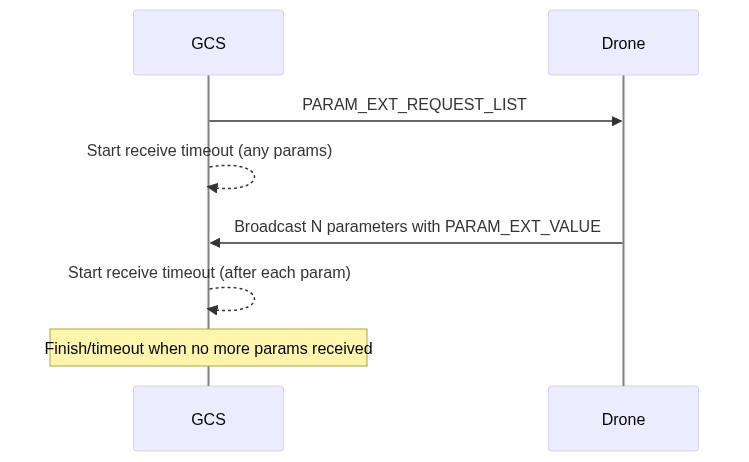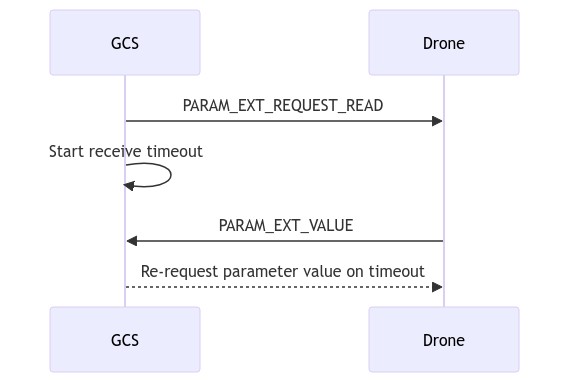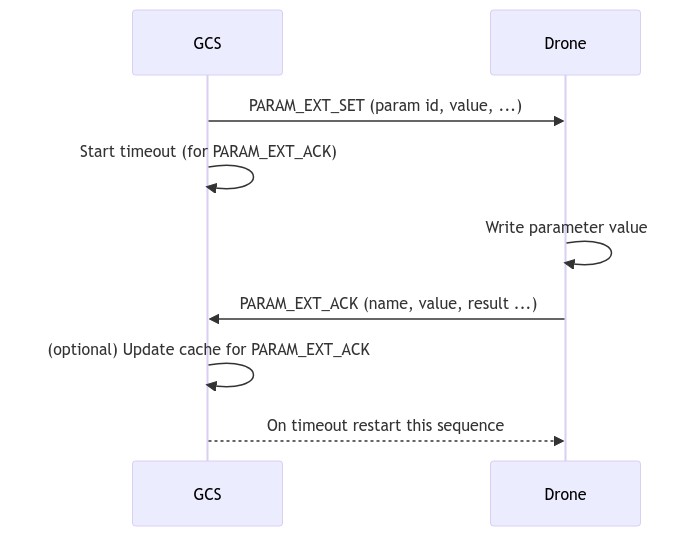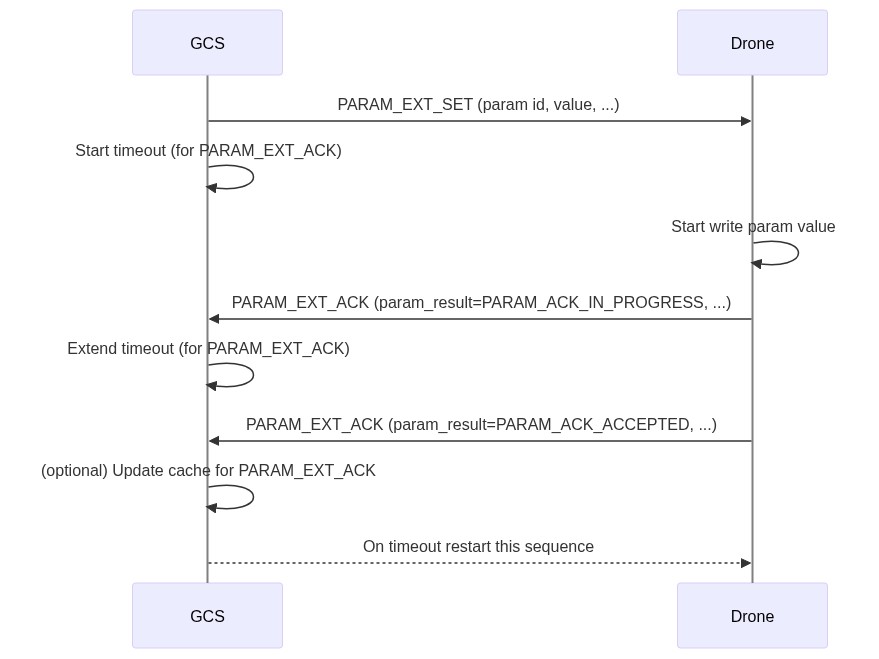Extended Parameter Protocol
The Extended Parameter Protocol is an extended version of the Parameter Protocol that adds support for larger custom parameter types e.g. strings. It can be used to exchange configuration settings between MAVLink components, and in particular configuration settings that may be more than just numeric values.
The protocol shares most of the same benefits and limitations of the original protocol, and similar (but not identical) operation sequences. The main difference is that when writing a parameter the system emits one or more PARAM_EXT_ACK messages (rather than PARAM_EXT_VALUE, as you would expect from the original protocol). This allows the Extended Parameter Protocol to differentiate between the case where a write fails (or is in progress) and the case where the value update simply went missing.
INFO
The extensions were invented for the Camera Protocol, which uses them to request/set parameter values specified in a Camera Definition File. At time of writing the protocol is supported by QGroundControl for this purpose, but is not otherwise supported by flight stacks.
Message/Enum Summary
| Message | Description |
|---|---|
| PARAM_EXT_REQUEST_LIST | Request all parameters of this component. On receiving this request, the requested component will emit all parameter values using PARAM_EXT_VALUE. |
| PARAM_EXT_VALUE | Emit the value of a parameter, following a PARAM_EXT_REQUEST_LIST or PARAM_EXT_REQUEST_READ. The message includes param_count and param_index which the recipient can use to track received parameters and re-request missing parameters after a timeout. |
| PARAM_EXT_REQUEST_READ | Request the value of a specific parameter using either its param_id or param_index. Expects a response in a PARAM_EXT_VALUE. |
| PARAM_EXT_SET | Set a parameter value. Expects immediate response PARAM_EXT_ACK with result indicating success, failure, or that the request is still in progress (PARAM_ACK_IN_PROGRESS). If in progress, additional update PARAM_EXT_ACK messages are expected. |
| PARAM_EXT_ACK | Response from a PARAM_EXT_SET message, which indicates whether the value was accepted (set), failed, setting is still in progress, or that the specified parameter is invalid/unsupported. |
| Enum | Description |
|---|---|
| MAV_PARAM_EXT_TYPE | Specifies the datatype of a MAVLink extended parameter (parameter values are encoded within the a char[128] array in the messages). This type conveys the real type of the encoded parameter value, e.g. MAV_PARAM_EXT_TYPE_REAL32. |
| PARAM_ACK | Request acknowledgment status value, sent in an PARAM_EXT_ACK as a response to a PARAM_EXT_SET message. A request can be accepted, fail, in-progress, or unsupported (indicating the specified parameter does not exist or has an invalid value or value type). |
Parameter Encoding
Parameters names/ids are set in the param_id field of messages where they are used. The param_id string can store up to 16 characters. The string is terminated with a NULL (\0) character if there are less than 16 human-readable chars, and without a null termination byte if the length is exactly 16 chars.
INFO
Names (as above) are the same as for the Parameter Protocol.
Values are byte-wise encoded within the param_value field, which is a char[128]. The param_type (MAV_PARAM_EXT_TYPE) is used to indicate the actual type of the data so that it can be decoded by the recipient. Supported types are: 8, 16, 32 and 64-bit signed and unsigned integers, 32 and 64-bit floating point numbers, and a "custom type" which may used for e.g. strings.
The encoding is best described by example as shown below.
C Encoding/Decoding
To send the parameter, the data is written into a union structure then memcpy used to copy the data into the message char[128] field.
The union structure might look like this:
MAVPACKED(
typedef struct {
union {
float param_float;
double param_double;
int64_t param_int64;
uint64_t param_uint64;
int32_t param_int32;
uint32_t param_uint32;
int16_t param_int16;
uint16_t param_uint16;
int8_t param_int8;
uint8_t param_uint8;
uint8_t bytes[MAVLINK_MSG_PARAM_EXT_SET_FIELD_PARAM_VALUE_LEN];
};
uint8_t type;
}) param_ext_union_t;To send the parameter, the data is written into the union value of the correct type and then memcpy used to copy it to the message data.
// Create C object for message data and zero fill
mavlink_param_ext_set_t p;
memset(&p, 0, sizeof(mavlink_param_ext_set_t));
// Store type of data to be sent in message
p.param_type = /* Value for type from MAV_PARAM_EXT_TYPE */;
// Create union value to assign data to
param_ext_union_t union_value;
// Assign data to union value (usually in a case statement based on type).
union_value.param_uint16 = static_cast<uint16_t>(aUint16Value);
// memcpy the union bytes value into the message data array.
memcpy(&p.param_value[0], &union_value.bytes[0], MAVLINK_MSG_PARAM_EXT_SET_FIELD_PARAM_VALUE_LEN);Receiving and decoding a parameter is even simpler:
// 'value' is the char[128] from the message
// 'param_type' is the param_type value from the message
// Create union value to assign data to
param_ext_union_t union_value;
// memcpy the received value into the union_value bytes field.
memcpy(union_value.bytes, value, MAVLINK_MSG_PARAM_EXT_SET_FIELD_PARAM_VALUE_LEN);
// Assign the union_value of correct type to a variable for use
switch (param_type) {
...
case MAV_PARAM_EXT_TYPE_INT16:
auto var = union_value.param_int16;
break;
...
}QGroundControl provides real code examples here:
- Union structure: QGCCameraIO.h::param_ext_union_t
- Send a parameter (encode in
char[128]): QGCCameraIO.cc::QGCCameraParamIO::_sendParameter() - Receive a parameter and get typed value: QGCCameraIO.cc::QGCCameraParamIO::_valueFromMessage()
Parameter Caching
A GCS or other component may choose to maintain a cache of parameter values for connected components/systems, in order to reduce the time required to display values and reduce MAVLink traffic.
The cache can be populated initially by first reading the full parameter list at least once, and then updated by monitoring for PARAM_EXT_ACK messages with PARAM_ACK_ACCEPTED (which are emitted whenever a parameter is successfully written/changed).
A system may also monitor for PARAM_EXT_VALUE originating from other components/systems requesting parameter values.
INFO
Cache synchronisation is not guaranteed; a component may miss parameter update messages due to changes by other components.
Limitations
Parameters Table is Invariant
The protocol requires that the parameter set does not change during normal operation/after parameters have been read.
If a component can add parameters during (or after) initial synchronization the protocol cannot guarantee reliable/robust synchronization, because there is no way to notify that the parameter set has changed and a new sync is required.
When requesting parameters from such a components, the risk of problems can be reduced (but not removed) if:
- The
param_idis used to read parameters where possible (the mapping ofparam_indexto a particular parameter may change on systems where parameters can be added/removed). - PARAM_EXT_VALUE.param_count may be monitored. If this changes the parameter set should be re-sychronised.
Parameter Synchronisation Can Fail
A GCS (or other system) that wants to cache parameters from a component and keep them synchronised should first get all parameters, and then track changes by monitoring for PARAM_EXT_ACK messages (updating their internal list appropriately).
This works for the originator of a parameter change, which can resend the request if an expected PARAM_EXT_ACK is not received. This approach may fail for components that did not originate the change, as they will not know about updates they do not receive (i.e. if messages are dropped).
A component may mitigate this risk by, for example, sending the PARAM_EXT_ACK multiple times after a parameter is changed.
Parameter Operations
This section defines the state machine/message sequences for all parameter operations.
Read All Parameters
The read-all operation is started by sending the PARAM_EXT_REQUEST_LIST message. The target component must start to broadcast the parameters individually in PARAM_EXT_VALUE messages after receiving this message. The drone should allow a pause after sending each parameter to ensure that the operation doesn't consume all of the available link bandwidth (30 - 50 percent of the bandwidth is reasonable).
The sequence of operations is:
- GCS (client) sends PARAM_EXT_REQUEST_LIST specifying a target system/component.
- Broadcast addresses may be used. All targeted components should respond with parameters (or ignore the request if they have none).
- The GCS is expected to accumulate parameters from all responding systems.
- The timeout/retry behaviour is GSC dependent.
- The targeted component(s) should respond, sending all parameters individually in PARAM_EXT_VALUE messages.
- Allow breaks between each message in order to avoid saturating the link.
- Components with no parameters should ignore the request.
- GCS starts timeout after each
PARAM_EXT_VALUEmessage in order to detect when parameters are no longer being sent (that the operation has completed).
Notes:
- The GCS/API may accumulate the received parameters for each component and can determine if any are missing/not received (
PARAM_EXT_VALUEcontains the total number of params and index of current param). - Handling of missing params is GCS-dependent. QGroundControl, for example, individually requests each missing parameter by index.
- If a component does not any parameters then it will ignore a
PARAM_EXT_REQUEST_LISTrequest. The sender should simply timeout (after resends) if noPARAM_EXT_VALUEis received.
Read Single Parameter
A single parameter can be read by sending the PARAM_EXT_REQUEST_READ message, as shown below:
The sequence of operations is:
- GCS (client) sends PARAM_EXT_REQUEST_READ specifying either the parameter id (name) or parameter index.
- GCS starts timeout waiting for acknowledgment (in the form of a PARAM_EXT_VALUE message).
- Drone responds with
PARAM_EXT_VALUEcontaining the parameter value. This is a broadcast message (sent to all systems).
The drone may restart the sequence if the PARAM_EXT_VALUE acknowledgment is not received within the timeout.
Write Parameters
Parameters are written individually using PARAM_EXT_SET. The recipient will respond with PARAM_EXT_ACK indicating success, failure, or that the write is still in progress (PARAM_ACK_IN_PROGRESS). On receipt of PARAM_ACK_IN_PROGRESS the component setting the parameter will extend its timeout (PARAM_EXT_ACK will be re-sent when the write completes)
Parameters can be written individually by sending the parameter name and value pair to the GCS, as shown:
For long-running write operations drone may initially respond with PARAM_ACK_IN_PROGRESS:
The sequence of operations is:
- GCS (client) sends PARAM_EXT_SET specifying the param name to update and its new value (also target system/component and the param type).
- GCS starts timout waiting for acknowledgment (in the form of a PARAM_EXT_ACK message).
- Drone (starts to) write parameter and responds by broadcasting a
PARAM_EXT_ACK.- If the write succeeded the
PARAM_EXT_ACKwill contain a result ofPARAM_ACK_ACCEPTEDand the updated parameter value. - If the parameter was unknown or of an unsupported type
PARAM_EXT_ACKwill contain a result ofPARAM_ACK_VALUE_UNSUPPORTEDand the current parameter value will be XXXXX. - If the write failed for another reason then
PARAM_EXT_ACKwill contain a result ofPARAM_ACK_FAILEDand the current parameter value. - If the write operation is long-running the
PARAM_EXT_ACKwill contain a result ofPARAM_ACK_IN_PROGRESSand the XXXX parameter value. In this case the recipient should increase their timeout and way for anotherPARAM_EXT_ACK.PARAM_EXT_ACKshould be resent when the operation completes.
- If the write succeeded the
- GCS should update the parameter cache (if used) with the new value.
- The GCS may restart the sequence if an expected
PARAM_EXT_ACKis not received within the timeout, or if the write operation fails.
Implementations
QGroundControl: QGCCameraIO.h, QGCCameraIO.cc





